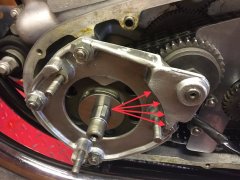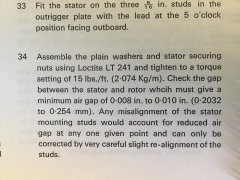Don’t forget the OP is running a MK3, so there is more to consider.
As I have said already, I have found the clearance is even less on a new genuine Lucas rotor and stator, when compared to the original so it is important to be careful.
We have turned down the rotor in the lathe to provide an air gap we are comfortable with taking into consideration crank flex.
On the topic of the rotor running concentrically inside the stator with an even gap all round, because it’s a MK3 you cannot take the usual route and either ‘waist’ the mounting studs or ream the holes in the stator to give you the wiggle room you need.
The reason being, the cast aluminium outrigger plate holds the stator in place not just on the three mounting studs, so it doesn’t give you the same degree of room for manoeuvre.
The answer, I’m afraid is to gently remove some of the material on the outrigger with a dremel.
Incidentally, I have seen a tight spot in exactly the same place on our own MK3 and several people online who have posted pics of similar.

We have reamed the holes in the stator - this allows us to move the stator over to the right and up a little.
It’s a good idea to use a cut up Coca-Cola drinks bottle wrapped around the rotor to ensure that clearance is right and stator is centred about the rotor.


